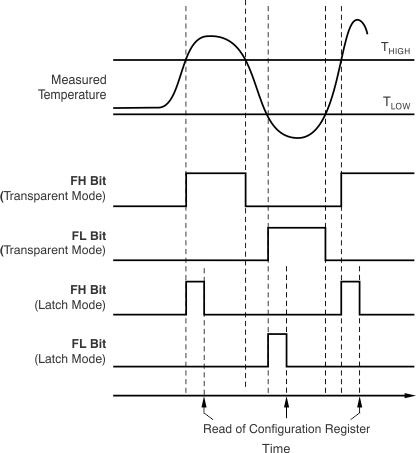SBOS564B November 2011 – December 2018 TMP104
PRODUCTION DATA.
- 1Features
- 2Applications
- 3Description
- 4Revision History
- 5Pin Configuration and Functions
- 6Specifications
- 7Detailed Description
- 8Device and Documentation Support
- 9Mechanical, Packaging, and Orderable Information
Package Options
Refer to the PDF data sheet for device specific package drawings
Mechanical Data (Package|Pins)
- YFF|4
Thermal pad, mechanical data (Package|Pins)
Orderable Information
7.4.2.1 Temperature Watchdog Function (FH, FL)
The TMP104 contains a watchdog function that monitors device temperature and compares the result to the values stored in the temperature limit registers (THIGH and TLOW) in order to determine if the device temperature is within these set limits. If the temperature of the TMP104 becomes greater than the value in the THIGH register, then the flag-high bit (FH) in the Configuration Register is set to '1'. If the temperature falls below value in the TLOW register, then the flag-low bit (FL) is set to '1'. If both flag bits remain '0', then the temperature is within the temperature window set by the temperature limit registers, as shown in Figure 13.
 Figure 13. Temperature Flag Functional Diagram
Figure 13. Temperature Flag Functional Diagram The latch bit (LC) in the Configuration Register is used to latch the value of the flag bits (FH and FL) until the master issues a read command to the Configuration Register. The flag bits are set to '0' if a read command is received by the TMP104, or if LC = 0 and the temperature is within the temperature limits. The power-on default values for these bits are FH = 0, FL = 0, and LC = 0.